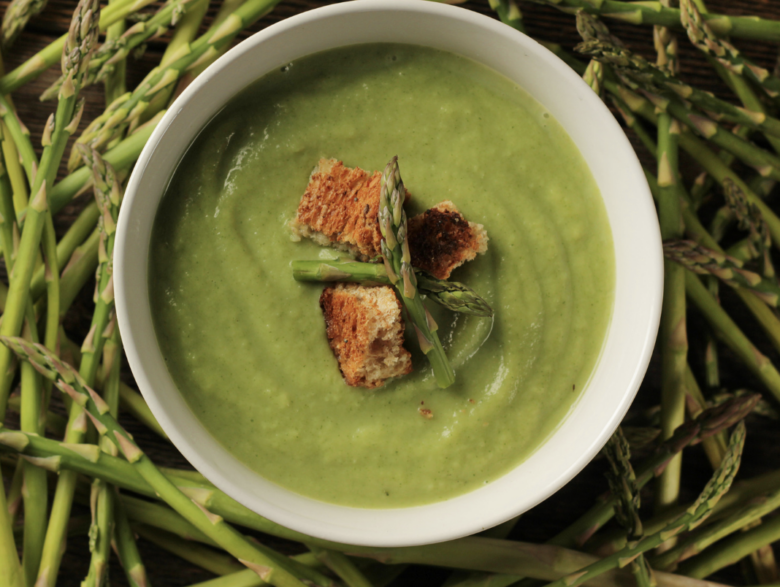Vegan asparagus soup with sugary peas and savory chives is the ideal way to greet spring since it is light, velvety, and packed with greens.
Even though March is the month often associated with the arrival of spring, I can still feel the cold weather beckoning me to this hearty soup. As the sun returns to its shining glory, the asparagus season, which begins in early March and lasts far into June, reaches its peak taste.
Indulge in this sophisticated asparagus soup that combines a variety of spring veggies. It’s the perfect dish to help you ease into summer after a long, dark winter. I adore soups and stews until the weather becomes warm enough for my Middle Eastern bones to consider them warm, so there’s no reason for me to cook one in the spring.
In this 30-minute dish, I combine the savory and sweet flavors of spring peas and asparagus with the aromatic qualities of leeks, garlic, and onions. Because there is no cream to mask the taste, the veggies really stand out.
It’s also great for a variety of occasions; you may have it as an appetizer at a dinner party or serve it in individual glasses to quench your thirst between drinks. Or as a side dish with pita, focaccia, or crusty bread for a lunchtime snack.
Asparagus soup calls for a variety of ingredients, such as the following: onions, garlic, celery, olive oil, leek, vegetable broth, frozen peas, bay leaf, salt, pepper, lemon juice, and chives.
The Elements of an Asparagus Soup
The buttery, sweet, and earthy asparagus takes center stage in this vegan soup, which is filled with vegetables. Things you’ll also need:
-Choose high-quality extra virgin olive oil to sauté the veggies in and then sprinkle over the soup for a finishing touch.
-The soup’s foundational aromatics—garlic, onions, and leek—serve to highlight the asparagus without overshadowing it.
-To choose good asparagus, choose stalks that are firm, green, and have tightly closed tips. Hold hold to the rinds; they’ll make a lovely garnish when added to the blended soup.
-You can get frozen peas any time of year and they don’t need shucking. If you prefer, you may use freshly shucked peas, which are in season from late spring until early summer. Feel free to use fresh peas, however.
-The bay leaf, whether it’s fresh or dried, adds a lovely aroma and a spicy taste to the soup.
-To make this soup even more vegan-friendly, try using a low-sodium homemade vegetable broth. If you want, you may also use store-bought or homemade chicken stock, although it will clearly change the taste profile of the soup. Keep in mind that if you’re not using a vegetarian broth with minimal sodium, you should season with less salt.
-Fresh lemon juice adds complimentary citrus overtones that bring out the asparagus’ natural sweetness.
-Season the soup with salt and pepper.
-A shot of some asparagus soup taken up close. On the other side, you can see a little dish with lemon wedges.
Making Asparagus Soup the Right Way
The first dish of this asparagus soup is perfect for a healthy lunch or a dinner party since it is both easy and elegant. The recipe is as follows:
Add 2 teaspoons of olive oil to a big soup pot or Dutch oven and set it over medium heat to cook the aromatics. Add one finely chopped onion and continue cooking until it becomes golden when the oil begins to shimmer. To release the garlic scent, add a bay leaf and a crushed clove of garlic, and stir until combined. Include 2 stalks of celery that have been finely chopped and 1 leek that has been sliced (only the white and delicate green parts). Simmer until they become tender.In a big saucepan, a wooden spoon is being used to sauté chopped celery, garlic, leeks, and an onion with a bay leaf.
Simmer the peas and asparagus in 6 cups of vegetable broth after bringing it to a boil. Chop and remove the tips from 1 ½ pounds of asparagus stalks; set aside 4 cups of frozen peas. Keep over low heat and cook until soft, about 20 minutes. Above: the asparagus soup in its raw, unblended state, photographed from above.
Finally, the soup: Once you’ve taken the bay leaf out of the soup, puree it using an immersion blender. Add salt, pepper, and lemon juice according to your preference. Cook, stirring occasionally, for another three minutes, or until the asparagus tips you set aside are just barely raw. In a big saucepan, the cooked asparagus soup is being pureed with an immersion blender.
To serve, divide the soup into bowls, cover with olive oil and chopped chives, and serve with crusty bread.A shot of some asparagus soup taken up close. The bowl of asparagus soup and the little platter of lemon wedges may be seen in the background.
Distinct varieties
For an extra burst of flavor and a lighter texture, try adding chopped fresh mint to this asparagus soup just before serving for a taste twist.
To add extra fullness to the soup, garnish it with feta and/or top it with a poached egg. For our method for poaching eggs, check out our recipe for Çılbır: Turkish Poached Eggs.
Our Watercress Soup with Peas and Mint is a vivacious, verdant soup that screams “springtime” and is sure to please any soup lover.
The image depicts two bowls of asparagus soup, one of which has a spoon inserted into it. A little dish with lemon wedges sits next them.
Asparagus Soup: What to Accompany It
A little olive oil and some finely chopped fresh chives make a simple garnish in the recipe below. Croutons, for a delightful crunch, are another option.
Garlic Bread, Roasted Garlic and Rosemary Focaccia, or crusty bread are other great accompaniments to this soup. Serve shrimp salad as an appetizer at a dinner party that is both formal and informal.
A view from above showing two serving bowls of asparagus soup accompanied by spoons. A little dish with lemon wedges sits next them.
Storage
You can make this asparagus soup ahead of time and store it in the fridge or freezer for later. The soup may be refrigerated for up to three days after cooling. Just seal it.
After the soup has cooled completely, it may be frozen. Store in the freezer for up to three months, being sure to give it enough room to expand as it freezes.
Let the soup thaw in the fridge overnight if you’re planning to reheat it from frozen. If the soup has been frozen or stored in the fridge, reheat it in the microwave or on medium heat on the stove. If it becomes too thick, add extra broth or water.



